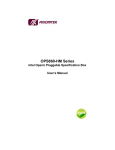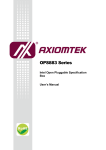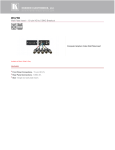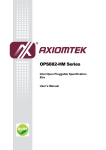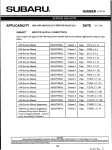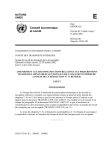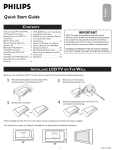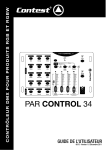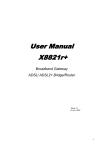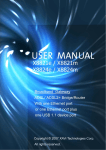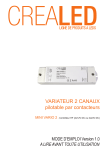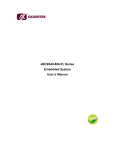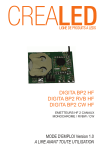Download User`s Manual
Transcript
DSB-500-860 Digital Signage Media Player User’s Manual Disclaimers This manual has been carefully checked and believed t o contain accurate information. Axiomtek Co., Ltd. assumes no responsibility for any infringements of patents or any third party’s rights, and any liability arising from such use. Axiomtek does not warrant or assume any legal liability or responsibility for the accuracy, completeness or usefulness of any information in this document. Axiomtek does not make any commitment to update the information in this manual. Axiomtek reserves the right to change or revise this document and/or product at any time without notice. No part of this document may be reproduced, stored in a retri eval system, or transmitted, in any form or by any means, electronic, mechanical, photocopying, recording, or otherwise, without the prior written permission of Axiomtek Co., Ltd. Copyright 2012 Axiomtek Co., Ltd. All Rights Reserved September 2012, Version A1 Printed in Taiwan ii Safety Precautions Before getting started, please read the following important safety precautions. 1. The DSB-500-860 does not come equipped with an operating system. An operating system must be loaded first before installing any software into the computer. 2. Be sure to ground yourself to prevent static charge when installing the internal components. Use a grounding wrist strap and place all electronic components in any static-shielded devices. Most electronic components are sensitive to static electrical charge. 3. Disconnect the power cord from the DSB-500-860 before making any installation. Be sure both the system and the external devices are turned OFF. Sudden surge of power could ruin sensitive components. Make sure the DSB-500-860 is properly grounded. 4. Make sure the voltage of the power source is correct before connecting the equipment to the power outlet. 5. Turn OFF the system power before cleaning. Clean the system using a cloth only. Do not spray any liquid cleaner directly onto the screen. 6. Do not leave this equipment in an uncontrolled environment where the storage temperature is below -20℃ or above 80℃. It may damage the equipment. 7. Do not open the system’s back cover. If opening the cover for m aintenance is a must, only a trained technician is allowed to do so. Integrated circuits on computer boards are sensitive to static electricity. To avoid damaging chips from electrostatic discharge, observe the following precautions: Before handling a board or integrated circuit, touch an unpainted portion of the system unit chassis for a few seconds. This will help to discharge any static electricity on your body. W hen handling boards and components, wear a wrist -grounding strap, available from most electronic component stores. iii Classification 1. Degree of production against electric shock : not classified 2. Equipment not suitable for use in the presence of a flammable anesthetic mixture with air or with oxygen or nitrous oxide. 3. Mode of operation : Continuous iv General Cleaning Tips You may need the following precautions before you begin to clean the computer. W hen you clean any single part or component for the computer, please read an d understand the details below fully. W hen you need to clean the device, please rub it with a piece of dry cloth. 1. Be cautious of the tiny removable components when you use a vacuum cleaner to absorb the dirt on the floor. 2. Turn the system off before you start to clean up the component or computer. 3. Never drop the components inside the computer or get circuit board damp or wet. 4. Be cautious of all kinds of cleaning solvents or chemicals when you use it for the sake of cleaning. Some individuals may be allergic to the ingredients. 5. Try not to put any food, drink or cigarette around the computer. Cleaning Tools: Although many companies have created products to help improve the process of cleaning your computer and peripherals users can also use household items to c lean their computers and peripherals. Below is a listing of items you may need or want to use while cleaning your computer or computer peripherals. Keep in mind that some components in your computer may only be able to be cleaned using a product designed for cleaning that component, if this is the case it will be mentioned in the cleaning. Cloth: A piece of cloth is the best tool to use when rubbing up a component. Although paper towels or tissues can be used on most hardware as well, we still recommend you to rub it with a piece of cloth. W ater or rubbing alcohol: You may moisten a piece of cloth a bit with some water or rubbing alcohol and rub it on the computer. Unknown solvents may be harmful to the plastics parts. Vacuum cleaner: Absorb the dust, dirt, hair, cigarette particles, and other particles out of a computer can be one of the best methods of cleaning a computer. Over time these items can restrict the airflow in a computer and cause circuitry to corrode. Cotton swabs: Cotton swaps moistened with rubbing alcohol or water are excellent tools for wiping hard to reach areas in your keyboard, mouse, and other locations. Foam swabs: W henever possible it is better to use lint free swabs such as foam swabs. Note: We strongly recommended that you should shut down the system before you start to clean any single components. Please follow the steps below: 1. Close all application programs 2. Close operating software 3. Turn off power switch 4. Remove all device 5. Pull out power cable v Scrap Computer Recycling If the computer equipments need the maintenance or are beyond repair, we strongly recommended that you should inform your Axiomtek distributor as soon as possible for the suitable solution. For the computers that are no longer useful or no longer working well, please contact your Axiomtek distributor for recycling and we will make the proper arrangement. Trademarks Acknowledgments Axiomtek is a trademark of Axiomtek Co., Ltd. Windows® is a trademark of Microsoft Corporation. AMI is trademark of American Megatrend Inc. IBM, PC/AT, PS/2, VGA are trademarks of International Business Machines Corporation. Intel® and Pentium® are trademarks of Intel Corporation. AMD is trademark of AMD Corporation, Inc. Other brand names and trademarks are the properties and registered Brands of their respective owners vi Table of Contents Disclaimers .................................................................................................................................. ii Safety Precautions ...................................................................................................................... iii Classification............................................................................................................................... iv General Cleaning Tips ................................................................................................................. v Scrap Computer Recycling ......................................................................................................... vi CHAPTER 1 INTRODUCTION ......................................................................................................... 1 1.1 General Description ................................................................................................... 2 1.2 System Specifications ................................................................................................ 3 1.2.1 CPU ........................................................................................................................... 3 1.2.2 I/O System ................................................................................................................. 3 1.2.3 System Specification .................................................................................................. 4 1.3 Dimensions ................................................................................................................ 5 1.3.1 System Dimension ..................................................................................................... 5 1.3.2 Wall mounts Bracket Dimension ................................................................................ 6 1.4 I/O Outlets .................................................................................................................. 7 1.5 Packing List................................................................................................................ 9 CHAPTER 2 HARDWARE INSTALLATION .................................................................................. 11 2.1 Installing the Memory Module .................................................................................. 12 2.2 Installing the SATA HDD .......................................................................................... 15 2.3 Installing the PCI-Express Mini Card ....................................................................... 17 2.4 Installing the Wall Mount (Optional) ......................................................................... 19 2.5 Installing the VESA Mount (optional) ....................................................................... 21 CHAPTER 3 JUMPER SETTING & CONNECTOR ....................................................................... 25 3.1 SBC layout ............................................................................................................... 25 3.2 Jumper Setting Summary ........................................................................................ 27 3.3 Connectors ............................................................................................................... 28 3.3.1 VGA Connector ........................................................................................................ 29 3.3.2 Mini card slot ............................................................................................................ 30 3.3.3 Battery 2pin .............................................................................................................. 31 3.3.4 ATX Auto power (SW1) / Clear CMOS (SW2)......................................................... 31 3.3.5 LAN .......................................................................................................................... 31 3.3.6 USB Port .................................................................................................................. 32 3.3.7 Audio Connector ...................................................................................................... 32 3.3.8 Display Port Connector ............................................................................................ 33 3.3.9 HDMI Connector ...................................................................................................... 34 3.3.10 DDR3 SODIMM Socket ........................................................................................... 35 CHAPTER 4 AMI BIOS SETUP UTILITY ...................................................................................... 37 4.1 Starting ..................................................................................................................... 37 4.2 Navigation Keys ....................................................................................................... 38 4.3 Main Menu ............................................................................................................... 39 4.4 Advanced Menu ....................................................................................................... 40 vii 4.5 4.6 4.7 4.8 Chipset Menu ........................................................................................................... 50 Boot Menu ................................................................................................................ 54 Security Menu .......................................................................................................... 56 Save & Exit Menu..................................................................................................... 58 APPENDIX A WATCHDOG TIMER ............................................................................................... 61 Sample Program ........................................................................................................................ 62 viii DSB-500-860 User’s Manual CHAPTER 1 INTRODUCTION This chapter contains general information and detailed specifications of the DSB-500-860. The Chapter 1 includes the following sections: General Description System Specification Dimensions I/O Outlets Package List Introduction 1 DSB-500-860 User’s Manual 1.1 General Description nd The DSB-500-860 is an embedded system that supports Intel 2 generation i3/i5/i7 processor to provide W indows® XPE, W indows 7® Embedded, W indows® XP, W indows® W inCE embedded and Linux, suitable for the most endurable operation. It features high performance design with full feature I/O, one 204-pin DDR3 SODIMM, and enhanced system dependability by built-in Watchdog Timer. Features 1. Intel® QM67 PCH 2. Support Intel 2 generation i3/i5/i7 processor 3. One 204-pin unbuffered SO-DIMM socket for single channel DDR3-1600 MHz memory, maximum memory capacity up to 8GB 4. One VGA port 5. One HDMI port 6. One DP port 7. Supports 4 USB 2.0 ports 8. Supports one 10/100/1000Mbps Ethernet port 9. One 2.5” SATA HDD/SSD drive bay(9.5mm height) nd 10. Watchdog timer 11. 90W adapter 12. Power cord 13. Wall mount (optional) 14. VESA mount (optional) 15. PCI-Express Mini Card Module (optional) 16. Antenna (optional) Reliable and Stable Design The DSB-500-860 adopts the advanced cooling system, which makes it especially suitable for vibration environments, best for industrial automation, digital signage and gaming application. Embedded O.S. Supported The DSB-500-860 not only supports Windows 7, Windows Vista, Windows XP, but also supports embedded OS, such as Windows XP embedded, WinCE and Linux. Various Storage devices supported For storage device, the DSB-500-860 supports one 2.5" SATA HDD drive bay. 2 Introduction DSB-500-860 User’s Manual 1.2 System Specifications 1.2.1 CPU CPU Intel® 2 nd generation i3/i5/i7 processor System Chipset Intel® QM67 PCH BIOS American Megatrends Inc. UEFI (Unified Extensible Firmware Interface) BIOS 16Mbit SPI Flash, DMI, Plug and Play System Memory One 204-pin unbuffered DDR3 SO-DIMM socket Maximum to 8GB DDR3 1600 MHz memory for i7 processor 1.2.2 I/O System One 15-pin D-Sub female connector for VGA One DP port One HDMI port One Audio phone jack (MIC-IN, Line-OUT) One RJ-45 connector for 10/100/1000Base-T Ethernet four USB 2.0 connectors One 19V DC Jack for power input connector Introduction 3 DSB-500-860 User’s Manual 1.2.3 System Specification Watchdog Timer Reset supported; 255 levels, 1~255 sec. Power Supply External [email protected], 90W AC/DC power adapter Operation Temperature 0℃ ~ 40℃ (32 ºF ~ 104ºF), Intel® 2 nd generation i7 processor Storage Temperature -20℃ ~ 80℃ (-4 ºF ~ 176ºF) Humidity 10% ~ 90% (non-condensation) Weight 1.5 kg without package 2.5 kg with package Dimensions 210mm(8.26”) (W) x 165mm(6.49”) (D) x 35mm(1.37”) (H) Note: All specifications and images are subject to change without notice. 4 Introduction DSB-500-860 User’s Manual 1.3 Dimensions The following diagrams show you dimensions and outlines of the DSB-500-860. 1.3.1 System Dimension Introduction 5 DSB-500-860 User’s Manual 1.3.2 6 Wall mounts Bracket Dimension Introduction DSB-500-860 User’s Manual 1.4 I/O Outlets The following figures show you I/O outlets on front view of the DSB-500-860. Front View Front View drawing Introduction 7 DSB-500-860 User’s Manual Rear View Rear View drawing 8 Introduction DSB-500-860 User’s Manual 1.5 Packing List The package bundled with your DSB-500-860 should contain the following items: DSB-500-860 System Unit x 1 CD x 1 (For Driver and User’s Manual) Screws pack x1 90W AC/DC Power Adapter Wall-mount Brackets (optional) If you cannot find this package or any items are missing, please contact Axiomtek distributors immediately. Introduction 9 DSB-500-860 User’s Manual MEMO: 10 Introduction DSB-500-860 User’s Manual CHAPTER 2 HARDWARE INSTALLATION The DSB-500-860 is convenient for your various hardware configurations, such as Memory Module, HDD (Hard Disk Drive), and SSD (Solid State Drive). The chapter 2 will show you how to install the hardware. Hardware Installation 11 DSB-500-860 User’s Manual 2.1 Installing the Memory Module Step 1 Turn off the system, and unplug the power cord. Step 2 Turn the system upside down to locate screws at the Bottom, loosen screws. Step 3 12 Remove the bottom cover. Hardware Installation DSB-500-860 User’s Manual Step 4 Locate the memory module, insert the gold colored Contact into the socket. Step 5 Push the module down, until it is firmly seated by locking two latches on the sides. Hardware Installation 13 DSB-500-860 User’s Manual Step 6 14 Close the cover to the chassis, and fasten all screws. Hardware Installation DSB-500-860 User’s Manual 2.2 Step 1 Installing the SATA HDD Turn off the system, and unplug the power cord. Step 2 Turn the system upside down to locate screws at the Front side, loosen screws. Step 3 Fasten all screws. Hardware Installation 15 DSB-500-860 User’s Manual Step 4 Close the bottom cover to the chassis, and fasten all of Screws. 16 Hardware Installation DSB-500-860 User’s Manual 2.3 Installing the PCI-Express Mini Card Step 1 Turn off the system, and unplug the power cord. Step 2 Turn the system upside down to locate screws at the Bottom, loosen screws. Step 3 Slide Mini cards into Mini Card slot with caution and Fasten screw of Express Mini Card. Hardware Installation 17 DSB-500-860 User’s Manual Step 4 Slide Mini cards into Mini Card slot with caution and Fasten screw of Express Mini Card. Step 5 Assembly the Top Cover back and fasten all screws. Note: In likely conditions, user may have to replace new thermal pads when existing thermal pad are damaged, dirty or missed. There are two thermal pads in the accessory kit for the need. 18 Hardware Installation DSB-500-860 User’s Manual 2.4 Installing the Wall Mount (Optional) The DSB-500-860 provides wall Mount that customers can install as below: Step 1 Prepare Wall Mount assembling components (screws and bracket) ready. Step 2 Fix the wall mount to the correct location, and fasten all screws. Hardware Installation 19 DSB-500-860 User’s Manual Step 3 20 Fix the wall mount to the correct location, and fas ten all screws. Hardware Installation DSB-500-860 User’s Manual 2.5 Installing the VESA Mount (optional) The DSB-500-860 provides VESA Mount that customers can install as below: Step 1 Prepare VESA Mount assembling components (screws and VESA mount bracket) ready. Step 2 Loose the screw of four footpads at the bottom of DSB-500-860, and remove footpad. Hardware Installation 21 DSB-500-860 User’s Manual Step 3 Put the DSB-500-860 into the VESA mount kit. Step 4 Fasten screws of VESA mount kit. 22 Hardware Installation DSB-500-860 User’s Manual Step 5 Decide correct mounting direction.DSB-500-860 supports 200x100mm VESA mount. The 200x100mm type has special direction. Hardware Installation 23 DSB-500-860 User’s Manual MEMO: 24 Hardware Installation DSB-500-860 User’s Manual CHAPTER 3 JUMPER SETTING & CONNECTOR Proper jumper settings configure the DSB-500-860 to meet your application purpose. We are herewith listing a summary table of all jumpers and default settings for onboard devices, respectively. 3.1 SBC layout TOP Side Jumper Setting & Connector 25 DSB-500-860 User’s Manual Bottom Side Note: We strongly recommended that you should not modify any unmentioned jumper setting without Axiomtek FAE’s instruction. Any modification without instruction might cause system to become damage. 26 Jumper Setting & Connector DSB-500-860 User’s Manual 3.2 Jumper Setting Summary Proper jumper settings configure the DSB-500-860 to meet your application purpose. W e are herewith listing a summary table of all jumpers and default se ttings for onboard devices, respectively. Here is a summary table shows you all connectors on the board. Connector Label ATX Auto Power On (SW -1) SW1 Clear CMOS (SW -2) Jumper Setting & Connector 27 DSB-500-860 User’s Manual 3.3 Connectors Connectors connect the board with other parts of the system. Loos e or improper connection might cause problems. Make sure all connectors are properly and firmly connected. Here is a summary table shows you all connectors on the DSB-500-860. Connector Label SATA 1 Power Connector CN2 CPU FAN CN3 Display Port (BOM Option) CN4 POW ER BUTTON CN5 RESET BUTTON CN6 VGA Port CN7 Mini Card Slot SCN1 Audio MIC-IN Connector SCN3 Audio LINE-OUT Connector SCN4 Battery 2 PIN BAT1 RJ45 (W G82579LM) LAN1 USB Port 0/1 USB1 LED SLED1 Power LED SLED2 HDD 28 Jumper Setting & Connector DSB-500-860 User’s Manual 3.3.1 VGA Connector DB15 CRT Connector (CN7) Co-layout with CN4 CN7 is a DB15 connector commonly used for the CRT Monitor. Pin Signal Pin Signal Pin Signal 1 Red 2 Green 3 Blue 4 N.C 5 GND 6 DETECT 7 GND 8 GND 9 VCC 10 GND 11 N.C 12 DDC DATA 13 Horizontal Sync 14 Vertical Sync 15 DDC CLK 5 1 10 15 Jumper Setting & Connector 6 11 29 DSB-500-860 User’s Manual 3.3.2 30 Mini card slot Pin Signal Pin Signal Pin Signal 1 WAKE# 2 3.3V 3 RVD1 4 GND 5 RVD2 6 +1.5V 7 CLKREQ# 8 RVD19 9 GND 10 RVD18 11 REFCLK- 12 RVD16 13 REFCLK+ 14 RVD15 15 GND 16 RVD14 17 RVD3 18 GND 19 RVD4 20 RVD13 21 GND 22 PERST# 23 PERN0 24 +3.3VAUX 25 PERP0 26 GND 27 GND 28 +1.5V 29 GND 30 SMB_CLK 31 PETN0 32 SMB_DATA 33 PETP0 34 GND 35 GND 36 USB_D- 37 RVD5 38 USB_D+ 39 RVD6 40 GND 41 +3.3VAUX 42 LED_WWAN# 43 RVD8 44 LED_WLAN# 45 RVD9 46 LED_WPAN# 47 RVD10 48 +1.5V 49 RVD11 50 GND 51 RVD12 52 +3.3V 53 NH1 54 NH2 55 NH3 56 NH4 Jumper Setting & Connector DSB-500-860 User’s Manual 3.3.3 3.3.4 3.3.5 Battery 2pin Pin Description 1 +VBAT 2 GND ATX Auto power (SW1) / Clear CMOS (SW2) SW On Off 1 Auto On ATX 2 Clear Normal LAN The RJ-45 connector LAN1 is for Ethernet. To connect the board to 100-Base-T or 1000Base-T hub, just plug one end of the cable into LAN1 and connect the other end (phone jack) to a 100-Base-T hub or 1000-Base-T hub. Pin Signal 1 Tx+ (Data transmission positive) 2 Tx- (Data transmission negative) 3 Rx+(Data reception positive) 4 RJ-1(For 1000 base T-Only) 5 RJ-1(For 1000 base T-Only) 6 Rx- (Data reception negative) 7 RJ-1(For 1000 base T-Only) 8 RJ-1(For 1000 base T-Only) A Active LED B Speed LED Jumper Setting & Connector A B 87654321 31 DSB-500-860 User’s Manual 3.3.6 USB Port Signal USB_POW ER USB USB + 1 2 3 4 GND 3.3.7 Audio Connector These two audio jacks ideal are for Audio Mic -In and Audio Line-out. 32 Pin Signal 1 Microphone In 2 Line Out Jumper Setting & Connector DSB-500-860 User’s Manual 3.3.8 Display Port Connector Display Port is a standard designed to replace digital (DVI) and analog component video (VGA) connectors in computer monitors and video cards, as wel l as replace internal digital LVDS links in computer monitor panels and TV panels. Pin Jumper Setting & Connector Signal 1 DPB_LANE0 2 GND 3 DPB_LANE0# 4 DPB_LANE1 5 GND 6 DPB_LANE1# 7 DPB_LANE2 8 GND 9 DPB_LANE2# 10 DPB_LANE3 11 GND 12 DPB_LANE3# 13 Detect Pin 14 GND 15 DPB_AUX 16 GND 17 DPB_AUX# 18 DPB_HPDE 19 GND 20 +3.3V 33 DSB-500-860 User’s Manual 3.3.9 HDMI Connector Pin 34 Signal 1 TMDS Data2+ 2 TMDS Data2 shield 3 TMDS Data2- 4 TMDS Data1+ 5 TMDS Data1 shield 6 TMDS Data1- 7 TMDS Data0+ 8 TMDS Data0 shield 9 TMDS Data0- 10 TMDS Clock+ 11 TMDS Clock shield 12 TMDS Clock- 13 CEC 14 Reserved, HEC Data- 15 SCL 16 SDA 17 DCC/CEC/HEC Ground 18 +5V 19 Hot Plug detect and HEC Data+ Jumper Setting & Connector DSB-500-860 User’s Manual 3.3.10 DDR3 SODIMM Socket DSB-500-860 supports standard DDR3 204-pin 1066/1333 MHz SO-DIMM pin define Jumper Setting & Connector 35 DSB-500-860 User’s Manual MEMO: 36 Jumper Setting & Connector DSB-500-860 User’s Manual CHAPTER 4 AMI BIOS SETUP UTILITY This chapter provides users with detailed description how to set up basic system configuration through the AMI BIOS setup utility. 4.1 Starting To enter the setup screens, follow the steps below: 1. Turn on the computer and press the <Del> key immediately. 2. After you press the <Delete> key, the main BIOS setup menu displays. You can access the other setup screens from the main BIOS setup menu, such as the Chipset and Power menus. AMI BIOS Setup Utility 37 DSB-500-860 User’s Manual 4.2 Navigation Keys The BIOS setup/utility uses a key-based navigation system called hot keys. Most of the BIOS setup utility hot keys can be used at any time during the setup navigation process. These keys include <F1>, <F10>, <Enter>, <ESC>, <Arrow> keys, and so on. Note: Some of navigation keys differ from one screen to another. Left/Right The Left and Right <Arrow> keys allow you to select a setup screen. Up/Down The Up and Down <Arrow> keys allow you to select a setup screen or sub-screen. + Plus/Minus Tab The Plus and Minus <Arrow> keys allow you to change the field value of a particular setup item. The <Tab> key allows you to select setup fields. F1 The <F1> key allows you to display the General Help screen. F10 The <F10> key allows you to save any changes you have made and exit Setup. Press the <F10> key to save your changes. Esc The <Esc> key allows you to discard any changes you have made and exit the Setup. Press the <Esc> key to exit the setup without saving your changes. Enter 38 The <Enter> key allows you to display or change the setup option listed for a particular setup item. The <Enter> key can also allow you to display the setup sub- screens. AMI BIOS Setup Utility DSB-500-860 User’s Manual 4.3 Main Menu W hen you first enter the Setup Utility, you will enter the Main setup screen. You can always return to the Main setup screen by selecting the Main tab. There are two Main Setup options. They are described in this section. The Main BIOS Setup screen is shown below. System Time/Date Use this option to change the system time and date. Highlight System Time or System Date using the <Arrow> keys. Enter new values through the keyboard. Press the <Tab> key or the <Arrow> keys to move between fields. The date must be entered in MM/DD/YY format. The time is entered in HH:MM:SS format. AMI BIOS Setup Utility 39 DSB-500-860 User’s Manual 4.4 Advanced Menu Launch PXE OpROM Use this item to enable or disable the Boot ROM function of the onboard LAN chip when the system boots up. Launch Storage OpROM This item can set enable or disable the storage device option ROM with C F device. The Advanced menu also allows users to set configuration of the CPU and other system devices. You can select any of the items in the left frame of the screen to go to the sub menus: ACPI Settings CPU Configuration SATA Configuration PCH-FW Configuration USB Configuration H/W Monitor For items marked with “”, please press <Enter> for more options. 40 AMI BIOS Setup Utility DSB-500-860 User’s Manual ACPI Settings You can use this screen to select options for the ACPI Configuration, and change the value of the selected option. A description of the selected item appears on the right side of the screen. ACPI Sleep State Allow you to select the Advanced Configuration and Power Interface (ACPI) state to be used for system suspend. Here are the options for your selection, S1 (CPU Stop Clock), S3 (Suspend to RAM) and Suspend Disable. AMI BIOS Setup Utility 41 DSB-500-860 User’s Manual CPU Configuration This screen shows the CPU Configuration, and you can change the value of the selected option. Active Processor Cores This feature controls the number of cores to e nable in each processor package Limit CPUID Maximum This determines the kind of basic information CPUID can provide the operating system. The maximum CPUID input value determines the values that operating system can write to the CPUID’s EAX register to obtain information about processor.(W hen the computer is booted up, the operating system executes the CPUID instruction to identify the processor and its capabilities. Before it can do so, it must first query the processor to find out the highest input value CPUID recognizes.) Execute Disable Bit Execute Disable Bit is a hardware-based security feature that can reduce exposure to viruses and malicious-code attacks and prevent harmful software from executing and propagating on the serve r o network 42 AMI BIOS Setup Utility DSB-500-860 User’s Manual Hardware Prefetcher Enabling/disabling hardware prefetch mechanisms on discrete applications can help system integrators and software developers obtain optimal performance for solutions running on Intel® Core™ Microarchitecture-based processors. Adjacent Cache Line Prefetch W hen enabled, the processor will retrieve the currently requested cache line, as well as the subsequent cache line. W hen disabled, the processor will only retrieve the currently requested cache line Intel Virtualization Technology Allows a hardware platform to run multiple operating systems separately and simultaneously, enabling one system to virtually function as several systems. AMI BIOS Setup Utility 43 DSB-500-860 User’s Manual SATA Configuration You can use this screen to select options for the SATA Configuration, and change the value of the selected option. A description of t he selected item appears on the right side of the screen. 44 AMI BIOS Setup Utility DSB-500-860 User’s Manual SATA Mode Use this item to choose the SATA operation mode. Here are the options for your selection, IDE Mode, AHCI Mode. Serial-ATA Controller 0 Use this item to control the onboard SATA controller. Here are the options for your selection, Compatible, Enhanced and Disable. Serial-ATA Controller 1 Use this item to control the onboard SATA controller. Here are the options for your selection, Enhanced and Disabled. AMI BIOS Setup Utility 45 DSB-500-860 User’s Manual PCH-FW Configuration You can use this screen to confirm ME Firmware version. 46 AMI BIOS Setup Utility DSB-500-860 User’s Manual USB Configuration You can use this screen to select options for the USB Configuration, and change the value of the selected option. A description of the selected item appears on the right side of the screen. Legacy USB Support This is for supporting USB device under legacy OS such DOS, when choosing AUTO”, the system will automatically detect any USB device is plugged into the computer and enable USB legacy mode when a USB device plugged and disable USB legacy mode when no USB device is plugged. AMI BIOS Setup Utility 47 DSB-500-860 User’s Manual H/W Monitor This screen shows the Hardware Health Configuration, and a description of the selected item appears on the right side of the screen 48 AMI BIOS Setup Utility DSB-500-860 User’s Manual AMI BIOS Setup Utility 49 DSB-500-860 User’s Manual 4.5 50 Chipset Menu AMI BIOS Setup Utility DSB-500-860 User’s Manual Graphics Configuration This option allows users to change the integrated graphic device settings. Aperture Size Aperture Size is a video configuration option that determines the amount of system memory available for direct access by the graphic s device. DVMT Pre-Allocated Pre-allocated memory is the small amount of system memory made available at boot time by the system BIOS for video. Pre -allocated memory is also known as locked memory. This is because it is "locked" for video use only and as s uch, is invisible and unable to be used by the operating system. DVMT Total GFx Mem. Allow you to allocate a fixed amount of system memory as graphics memory. Here are the options for your selection, 128MB, 256MB and Maximum DVMT AMI BIOS Setup Utility 51 DSB-500-860 User’s Manual Memory Information Memory Configuration This screen shows the memory information. 52 AMI BIOS Setup Utility DSB-500-860 User’s Manual USB Configuration You can use this item to set the USB Configuration. AMI BIOS Setup Utility 53 DSB-500-860 User’s Manual 4.6 Boot Menu The Boot menu allows users to change boot options of the system. You ca n select any of the items in the left frame of the screen to go to the sub menus: Setup Prompt Timeout Boot up Mum Lock State Quiet Boot CSM16 Module Version GateA20 Active Boot Option Priorities 54 AMI BIOS Setup Utility DSB-500-860 User’s Manual Setup Prompt Timeout Set the Timeout for wait press key to enter Setup Menu Boot up Mum Lock State Use this item to select the power-on state for the Mum Lock. The default setting is on. Quiet Boot Use this item to enable or disable the Quite Boot state. The default setting is disabling. Boot Option #1 First Boot Device Hard Drive BBS Priorities Prioritize the booting hard drive. AMI BIOS Setup Utility 55 DSB-500-860 User’s Manual 4.7 Security Menu The Security menu allows users to change the security settings for the system. 56 AMI BIOS Setup Utility DSB-500-860 User’s Manual Administrator Password This item indicates whether an administrator password has been set. If the password has been installed, Installed displays. If not, Not Installed displays. User Password This item indicates whether a user password has been set. If the password has been installed, Installed displays. If not, Not Installed displays. HDD Security Configuration AMI BIOS Setup Utility 57 DSB-500-860 User’s Manual 4.8 Save & Exit Menu The Save & Exit menu allows users to load your system configuration with optim al or failsafe default values. Save Changes and Exit W hen you have completed the system configuration changes, select this option to leave Setup and return to Main Menu. Select Save Changes and Exit from the Save & Exit menu and press <Enter>. Select Yes to save changes and exit. Discard Changes and Exit Select this option to quit Setup without making any permanent changes to the system configuration and return to Main Menu. Select Discard Changes and Exit from the Save & Exit menu and press <Enter>. Select Yes to discard changes and exit. Save Changes and Reset W hen you have completed the system configuration changes, select this option to leave Setup and reboot the computer so the new system configuration parameters can take effect. Select Save Changes and Reset from the Save & Exit menu and press <Enter>. Select Yes to save changes and reset. 58 AMI BIOS Setup Utility DSB-500-860 User’s Manual Discard Changes and Reset Select this option to quit Setup without making any permanent changes to the system configuration and reboot the computer. Select Discard Changes and Reset from the Save & Exit menu and press <Enter>. Select Yes to discard changes and reset. Save Changes W hen you have completed the system configuration changes, select this option to save changes. Select Save Changes from the Save & Exit menu and press <Enter>. Select Yes to save changes. Discard Changes Select this option to quit Setup without making any permanent changes to the system configuration. Select Discard Changes from the Save & Exit menu and press <Enter>. Select Yes to discard changes. Restore Defaults It automatically sets all Setup options to a complete set of default settings when you select this option. The Optimal settings are designed for maximum system performance, but may not work best for all computer applications. In particular, do not use the Optimal Setup options if your computer is experiencing system configuration problems. Select Restore Defaults from the save & Exit menu and press <Enter>. Save as User Defaults Restore User Default AMI BIOS Setup Utility 59 DSB-500-860 User’s Manual MEMO: 60 AMI BIOS Setup Utility DSB-500-860 User’s Manual APPENDIX A WATCHDOG TIMER About Watchdog Timer Software stability is major issue in most application. Some embedded systems are not watched by human for 24 hours. It is usually too slow to wait for someone to reboot when computer hangs. The systems need to be able to reset automatically when thi ngs go wrong. The watchdog timer gives us solution. The watchdog timer is a counter that triggers a system reset when it counts down to zero from a preset value. The software starts counter with an initial value and must reset it periodically. If the counter ever reaches zero which means the software has crashed, the system will reboot. How to Use Watchdog Timer The I/O port base addresses of watchdog timer are 2E (hex) and 2F (hex). The 2E (hex) and 2F (hex) are address and data port respectively. Assume that program A is put in a loop that must execute at least once every 10ms. Initialize watchdog timer with a value bigger than 10ms. If the software has no problems; watchdog timer will never expire because software will always restart the counter before it reaches zero. Begin Next Enable and Initialize Watchdog Timer Next Program “A” Next Disable Watchdog Timer Next Watchdog Timer Begin Next Enable and Initialize Watchdog Timer Next Program “A” Next Reset Watchdog Timer Next 61 DSB-500-860 User’s Manual Sample Program Assembly sample code : ;Enable WDT: mov dx,2Eh mov al,87 out dx,al out dx,al ;Un-lock super I/O ;Select Logic device: mov dx,2Eh mov al,07h out dx,al mov dx,2Fh mov al,08h out dx,al ;Activate WDT: mov dx,2Eh mov al,30h out dx,al mov dx,2Fh mov al,01h out dx,al ;Set Second or Minute : mov dx,2Eh mov al,0F5h out dx,al mov dx,2Fh mov al,Nh out dx,al 62 ;N=00h or 08h(see below Note) Watchdog Timer DSB-500-860 User’s Manual ;Set base timer : mov dx,2Eh mov al,0F6h out dx,al mov dx,2Fh mov al,Mh ;M=00h,01h,...FFh (hex),Value=0 to 255 out dx,al ;(see below Note) ;Disable WDT: mov dx,2Eh mov al,30h out dx,al mov dx,2Fh mov al,00h out dx,al ;Can be disabled at any time Note: If N=00h, the time base is set to second. M = time value 00: Time-out Disable 01: Time-out occurs after 1 second 02: Time-out occurs after 2 seconds 03: Time-out occurs after 3 seconds . . FFh: Time-out occurs after 255 seconds Watchdog Timer 63 DSB-500-860 User’s Manual If N=08h, the time base is set to minute. M = time value 00: Time-out Disable 01: Time-out occurs after 1 minute 02: Time-out occurs after 2 minutes 03: Time-out occurs after 3 minutes . . FFh: Time-out occurs after 255 minutes 64 Watchdog Timer










































































